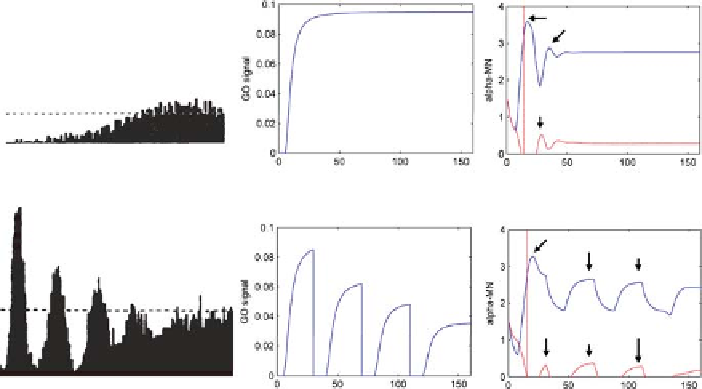Information Technology Reference
In-Depth Information
AG are needed to complete the movement. According to the model, disruptions of
the GO signal and dopamine depletion in the cortex and spinal cord disrupt the
reciprocal organization of M1 neurons, reduce their activity, increase their rate of
change, and hence result in the downscaling of the size of the first agonist burst
and in the increase of its rate of change. So, in order for the subject to complete
the movement and reach the target, additional EMG bursts are required. Figure 11.7
shows a qualitative comparison of the normal (column 1) and dopamine-depleted
(column 2) simulated alpha motoneuronal (MN) activities of the agonist and antag-
onist muscles. A significant reduction in the peak agonist and antagonist amplitude
as well as of their rate of development is evident [50, 23, 37, 17]. In contrast to some
PD studies [2, 24, 40], a single and non co-contractive agonist-antagonist pattern of
muscle activation is observed (column 2 of figure 11.7). Figure 11.8 shows a qual-
itative comparison of the experimental (column 1) and simulated (column 2) GPi
discharge patterns (GO signal) and
-MN activity (column 3) in normal (row 1)
and PD (row 2) large amplitude movement conditions. An abnormal oscillatory GO
signal and DA depletion in the cortex and spinal cord result in a repetitive bipha-
sic pattern of muscle activation (indicated by the arrows) necessary to complete the
movement [37]. In the model, the generation of such repetitive biphasic pattern of
α
Fig. 11.8: Comparison of the experimental GPi PSTH (column 1), GO signals (col-
umn 2), and
-MN activities (column 3) in normal (row 1) and dopamine-depleted
(row 2) conditions. (
Column 3, rows 1 and 2
)
Blue-colored solid curve
: agonist
α
α
-MN unit;
Red-colored dashed curve
: antagonist
α
-MN unit. Note in dopamine-
depleted case the
-MN activity is disrupted and replaced by repetitive and co-
contractive agonist-antagonist bursts (
row 2, column 3
). (
Column 1, row 1
)GPi
PSTH in intact monkey reproduced with permission from Tremblay et al. [49, Fig. 4,
p. 6], Copyright Elsevier. (
Column1, row 2
) GPi PSTH in MPTP monkey reproduced
with permission from [49, Fig. 2, p. 23], Copyright Elsevier.
α

